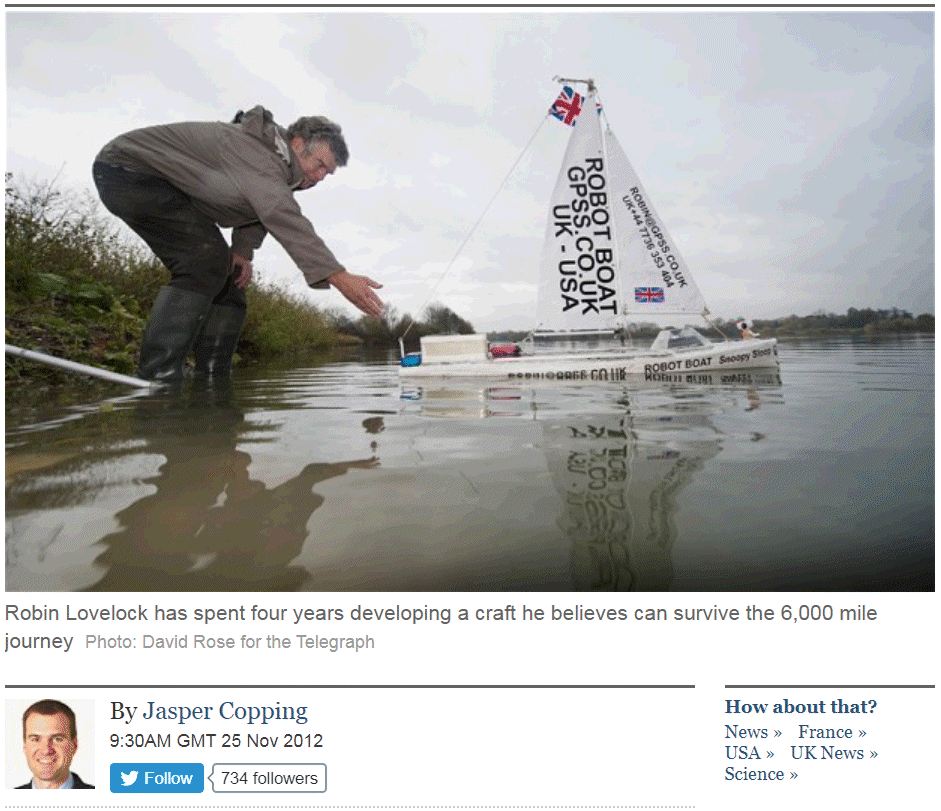These pages may not present clearly on some small smartphone screens; please use a normal large screen on a desktop, laptop, or tablet in landscape mode. Thankyou.
Robin Lovelock.


 Snoopy the Viking will attempt the Atlantic again, from UK to USA, in his little robot boat.
The "Microtransat Challenge" is a French idea.
Snoopy the Viking will attempt the Atlantic again, from UK to USA, in his little robot boat.
The "Microtransat Challenge" is a French idea.
Snoopy's rescue in 2015: See
2015 Attempt
and the I-GotU track. Robin thanks the Royal Marines SBS. Beers ?
Video on left added.
from Robin: see my
Home
page, for an introduction to who I am. e.g. the Dr Strangelove video on the right. Love and Strength to All.
See below for the details of Snoopy's UK to USA Atlantic Attempts and testing of Team-Joker's boats for the next.

Home .
About .
GPS .
Downloads .
Business .
Partners .
Contact .
Family .
AVL .
Links .
History .
AsOnTV .
Holidays .
NHSCare.info .
Grumpy .
Snoopy
Cliquez sur le drapeau français ci-dessus si vous préférez grenouilles et les escargots à Roast Beef :-)









 from Robin Lovelock: The excellent article below, by Jasper Copping, appeared in the Sunday Telegraph the Sunday before the 2012 launch attempt.
The online version appeared on their website soon after, and my
Snoopy
page includes a link to it:
"Read
Jasper Coppings article in the Sunday Telegraph the Sunday before launch".
However, in 2020, I found that you could only read the article, and other services, if you signed up to pay for it.
It seemed a good idea to back up the article into my triplicated web space, so it does not get lost. There is another benifit - you can translate
it to any language. The article is, of course, Copyright of the Sunday Telegraph, although they may wish to check the terms
under which I agreed to the session at Bray Lake, and the article being published :-)
from Robin Lovelock: The excellent article below, by Jasper Copping, appeared in the Sunday Telegraph the Sunday before the 2012 launch attempt.
The online version appeared on their website soon after, and my
Snoopy
page includes a link to it:
"Read
Jasper Coppings article in the Sunday Telegraph the Sunday before launch".
However, in 2020, I found that you could only read the article, and other services, if you signed up to pay for it.
It seemed a good idea to back up the article into my triplicated web space, so it does not get lost. There is another benifit - you can translate
it to any language. The article is, of course, Copyright of the Sunday Telegraph, although they may wish to check the terms
under which I agreed to the session at Bray Lake, and the article being published :-)
Snoopy Sloop: the unmanned toy boat attempting Atlantic crossing

It sounds like an unlikely conqueror of the Atlantic - only 4ft long, weighing just 30lbs and held together in parts by bathroom light cord.
But this week a toy boat called Snoopy Sloop will follow in the wake of Transatlantic pioneers like Christopher Columbus when it attempts to become the first craft to make an unmanned crossing of the ocean.
Its creator Robin Lovelock, a retired Nato scientist, has spent four years developing a craft he believes can survive the 6,000 mile journey.
The vessel has already demonstrated its endurance, having completed more than 5,000 miles during seven months of almost continuous sailing, albeit on the gentler waters of Bray Lake, just off the M4 motorway near Windsor.
Now it faces a more testing voyage, battling the seas, and possibly storms, of the North Atlantic, despite being a fraction of the size of shipping which normally makes the winter crossing.
Mr Lovelock, 65, has assembled the vessel in the games room of his house in Sunninghill, Berkshire, from off-the-shelf parts scoured from the internet at a cost of less than £450. The boat will be powered by the wind, but navigated by a solar-powered computer and GPS system.
These will control the rudder and – it is hoped – steer the boat on a preprogrammed route along the Channel, then south towards the Azores to catch the trade winds to the Bahamas and onwards to land near the spot where the Pilgrim Fathers came ashore at Plymouth, Massachusetts.
A tracking device will emit a signal every hour to update Mr Lovelock back home about the boat’s progress – or otherwise.
The 30lb vessel is expected to crawl along at around three miles an hour and – if all goes to plan – will not reach its destination for up to six months.
Weather permitting, it will begin its Transatlantic journey from Barton-on-Sea, Hampshire, on Saturday. Autumn is not the most auspicious time to cross the Atlantic, in any sort of vessel, but there is no time to spare as the craft could face competition.
The attempt is being made as part of an international contest, the Microtransat Challenge, to become the first to send an unmanned from south of Ireland to the Bahamas.
Competitors can set off whenever they wish. So far, three attempts have been made since the transatlantic challenge began in 2010 – two by French academics and one by a team from the University of Aberystwyth – all of which have been defeated by a combination of technology failures and the weather.
Three more are registered to attempt the crossing this year, two from France and one from Norway.
Mr Lovelock’s entry is rather more homespun than the hi-tech and better resourced craft which have so far failed the Transatlantic challenge but he is convinced it can succeed, after four years of development and seven prototypes - two of which sank - all put through their paces on Bray Lake.
The small figure of the cartoon character Snoopy on board was installed “as a wind up to academics who take it too seriously”.
Sceptics should note that since April, Mr Lovelock, who used to develop military computer systems for Nato, has left Snoopy Sloop to continuously sail a preprogrammed course around the lake, totalling up around 5,500 miles – almost as far as his planned route and comfortably enough to win the challenge, which only requires vessels
The only interruptions have been to make the odd modification, and to retrieve it when it drifts into the bank when the wind drops. “Thankfully that isn’t something we have to worry about at sea,” he said.
On Bray Lake the yacht has faced winds of up to 50mph, but few waves to speak of – although the waters there were treacherous enough to claim two of the prototypes, which sank.
Mr Lovelock is relaxed about some of the hazards and concerned about others.
“The chances of an encounter with another vessel are so small, and Snoopy should just be brushed out of the way,” he said. “Birds on Bray Lake do like to perch on the boat, but when the wind blows the sea gulls won’t like it, and any mess on the deck will be washed off. It may not have faced big waves yet, but its small size means it should just be able to ride the swell.
“There are certain things to worry about and others not to. The likely problems will be with reliability, and how the navigation system works with the tides.”
Scientists interested in developing such craft believe that in the future they will be able to undertake sampling expeditions to collect data to help in the study of weather and the chemistry of the sea, as well as monitor events like plankton blooms and oil spills.
Mr Lovelock, who used to run his own software business has been assisted by a group of friends, he has described as his “Last of the Summer Wine” team, including a former veteran of the Robot Wars BBC television show.
“I got hooked about four years ago. I didn’t even play with model boats when I was a boy. I sometimes tinker on the boat in the lounge, but am usually banished to the games room by my wife.”
While the voyage ahead is a daunting one, Mr Lovelock clearly feels there are some grounds for optimism – Snoopy Sloop has already been programmed for a return trip from the US, back to Barnstaple, in Britain.
What the boat consists of:
– A second hand hull, brought via the internet from a model enthusiast, for £35, and filled with expanding foam used by builders (£7) for added buoyancy.
– Off the shelf model boat sails (£40), strengthened with sticky vinyl sheets (£5) from eBay. The 3ft high sails are identical to those used on basic model boats. To keep the boat simple and reduce the chances of it developing a fault at sea, the sails cannot be altered by the computer. They are fixed at an angle of around 30 degrees from the centre.
– The sails are fixed to the boat using around five metres of synthetic string from a hardware store usually used for the cord on a bathroom light (£5)
– GPS (£20) from the internet. Gives position and direction the computer.
– Basic “PicAxe” computer (£10) as used in schools and hobby projects. Does all the navigation and steering by controlling the rudder.
- “Servo” (£7) – a small motor, which manipulates the rudder. Standard device for model boat enthusiasts.
– Tracker system and computer (£150), also from the internet. Receives information from the GPS and stores information about the route. Controls rudder and sends information back to mission headquarters in Sunninghill, Berkshire.
– 5V battery (£10) – recharged by eight solar panels (£14 each).
- Silicone sealant (£7)
– Solar-powered light (£40)
– Snoopy figure (£1) from eBay
Total: £449
Who has visited this page ?
The visit counters give a rough indication on who else is visiting this page,
and are explained at the bottom of the
Snoopy
page.
e.g. I don't try to hide my visits, and they may come up as "Ascot", or miles away, like "Godalming" or "Houghton-Le-Spring".
© 1991-2020 Robin Lovelock and © 2012 Sunday Telegraph.


 Snoopy the Viking will attempt the Atlantic again, from UK to USA, in his little robot boat.
The "Microtransat Challenge" is a French idea.
Snoopy the Viking will attempt the Atlantic again, from UK to USA, in his little robot boat.
The "Microtransat Challenge" is a French idea.

![]()
![]()
![]()
![]()
![]()
![]()
![]()
![]()
![]()
 from Robin Lovelock: The excellent article below, by Jasper Copping, appeared in the Sunday Telegraph the Sunday before the 2012 launch attempt.
The online version appeared on their website soon after, and my
Snoopy
page includes a link to it:
"Read
Jasper Coppings article in the Sunday Telegraph the Sunday before launch".
However, in 2020, I found that you could only read the article, and other services, if you signed up to pay for it.
It seemed a good idea to back up the article into my triplicated web space, so it does not get lost. There is another benifit - you can translate
it to any language. The article is, of course, Copyright of the Sunday Telegraph, although they may wish to check the terms
under which I agreed to the session at Bray Lake, and the article being published :-)
from Robin Lovelock: The excellent article below, by Jasper Copping, appeared in the Sunday Telegraph the Sunday before the 2012 launch attempt.
The online version appeared on their website soon after, and my
Snoopy
page includes a link to it:
"Read
Jasper Coppings article in the Sunday Telegraph the Sunday before launch".
However, in 2020, I found that you could only read the article, and other services, if you signed up to pay for it.
It seemed a good idea to back up the article into my triplicated web space, so it does not get lost. There is another benifit - you can translate
it to any language. The article is, of course, Copyright of the Sunday Telegraph, although they may wish to check the terms
under which I agreed to the session at Bray Lake, and the article being published :-)
